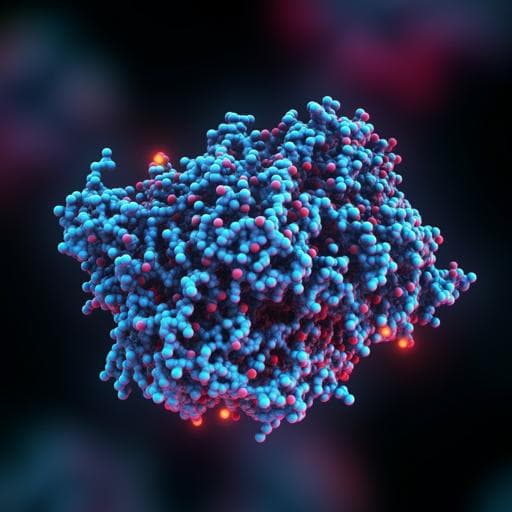
Medicine and Health
Computational identification of HCV neutralizing antibodies with a common HCDR3 disulfide bond motif in the antibody repertoires of infected individuals
N. G. Bozhanova, A. I. Flyak, et al.
Discover groundbreaking research addressing the need for an HCV vaccine despite successful antiviral treatments. This study by Nina G. Bozhanova, Andrew I. Flyak, and others revealed new broadly neutralizing antibodies with unique structural features that could reshape the future of HCV prevention.
~3 min • Beginner • English
Introduction
Hepatitis C virus remains a major global health challenge despite direct-acting antivirals (DAAs). Many infected individuals are unaware of infection and DAAs do not prevent reinfection, while resistant variants can emerge, underscoring the need for a protective vaccine. Broadly neutralizing antibodies (bNAbs), especially those targeting the conserved antigenic region 3 (AR3) on E2 encompassing the front layer and CD81 binding loop, are associated with spontaneous clearance. A prominent subset of AR3-directed bNAbs derives from the VH1-69 gene and features an unusual HCDR3 with an intra-loop disulfide bond that forms a β-hairpin. These antibodies vary in approach angle and footprint and can be grouped by HCDR3 loop conformation (straight vs bent). The study aims to identify additional members of this structural class from human repertoires using a structure-guided, sequence-agnostic computational approach, and to define sequence-structure determinants governing HCDR3 conformation and E2 recognition to inform epitope-focused vaccine design.
Literature Review
Prior work identified multiple AR3-specific VH1-69-derived bNAbs (e.g., HEPC3, HEPC74, AR3A, AR3C, AR3X, HC11) from donors with chronic or cleared HCV infections. Structural studies showed recognition is dominated by HCDR3-mediated interactions with E2’s front layer, with a disulfide-stabilized β-hairpin motif in HCDR3. Chen et al. described subgrouping by approach and footprint, including bent vs straight HCDR3 conformations. The canonical motif R/K–Y–C–G–G–G–X–C was proposed as important for E2 recognition, with cysteines and central glycines critical for hairpin formation. Structure-based screening (e.g., P3SM) has been used for other pathogens (HIV PG9, influenza CH65, Marburg MR78), motivating its application to HCV bNAb discovery.
Methodology
- Antibody repertoire sources: Heavy chain sequence libraries were obtained from two individuals with a history of spontaneous HCV clearance (C110 and C117), previously used to isolate HEPC74 and HEPC3, respectively. Libraries were filtered for VH1-69 sequences.
- Sequence-based sibling search: Conventional search (≥75% HCDR3 identity with same V/J) identified two HEPC3-like siblings (HEPC3-sibl1, HEPC3-sibl2) from C117; none from C110.
- Structure-guided screening (P3SM): Employed a Rosetta-based Position-Specific Structure Scoring Matrix. Templates were HEPC3 (19-residue HCDR3) and AR3C (20-residue HCDR3). The method required exact HCDR3 length match and presence of a C–X–G–G–X–C motif at positions 8–13 (19-mers) or 9–14 (20-mers). Training sets of 1200 naturally occurring HCDR3s per template (from healthy donor NGS) were threaded onto Ab–E2 complexes and relaxed; the five lowest-energy models per sequence contributed to a ridge-regressed position-specific scoring matrix (using total score and interface score). Candidate sequences from C110/C117 matching length and motif were scored, top-ranked were modeled, and manually inspected for realistic geometry and interactions.
- Candidate selection and expression: From 124 (19-mer) and 71 (20-mer) candidates, 35 and 18 were prioritized; after manual review, eight HEPC3-like (19-mer) and two AR3C-like (20-mer) HCDR3s were selected. For each HCDR3, chimeric Abs (HCDR3 grafted into HEPC3 or AR3C heavy chain frameworks) and native heavy chain variable region Abs were cloned. Sibling Abs were expressed as full-length sequences. All heavy chains were paired with HEPC3-VL (for 19-mers) or AR3C-VL (for 20-mers). IgGs and Fabs were produced in Expi293F cells and purified by Protein A/His affinity and SEC.
- Binding assays: ELISA against a panel of genotype 1 E2 ectodomains (residues 384–643); EC50 and AUC calculated. Specificity for AR3 was assessed using an E2 variant (1a157 E2ecto ΔFRLY) with alanine substitutions disrupting AR3 bNAb binding while preserving AS412 bNAb HC33.1 binding.
- Neutralization assays: HCV pseudoparticles (HCVpp) across genotypes 1–6; IgGs serially diluted and IC50 values computed from luciferase readout in Hep3B cells.
- Crystallography: Apo Fab structures of HEPC3.1 and HEPC3.4 were solved at 2.8 Å and 3.3 Å, respectively (SSRL BL12-2). Molecular replacement using HEPC3/HEPC3.1; refinement in Phenix with manual rebuilding in Coot; validation by MolProbity.
- Structural bioinformatics: Surveyed PDB for human Abs (≤3.0 Å) with mid-HCDR3 CXXXXC motif; 27 unique HCDR3s characterized. Quantified HCDR3 tip positioning relative to Fv by geometric descriptors (angles/dihedrals) and examined sequence correlates with conformation.
- Molecular dynamics (MD): Extensive explicit-solvent Amber20 simulations for HEPC3, HEPC3.1, HEPC3.4 and variants altering positions 97 and 100 (HEPC3-PG; HEPC3.1-VN; HEPC3.4-VN). Each Ab simulated from both straight (HEPC3-like) and bent (HEPC3.1/3.4-like) starting conformations. Total production time 360 µs across systems. Analyses used TICA on 1497 geometric features to identify kinetically relevant conformational clusters and preferences.
Key Findings
- Discovery and binding: Of 22 engineered/tested antibodies (including chimeric and native constructs from 10 P3SM-selected HCDR3s and 2 siblings), seven bound genotype 1 E2 ectodomains in ELISA. No binding was observed among 10 randomly selected C–X–G–G–X–C motif-containing controls, indicating enrichment by P3SM. Native constructs showed stronger and broader binding than their chimeric counterparts in cases tested (e.g., HEPC3.1 vs HEPC3.1HCDR3; HEPC3.4 vs HEPC3.4HCDR3).
- Sibling Abs: HEPC3-sibl1 exhibited the greatest breadth among new Abs, failing to bind only one E2 glycoprotein that HEPC3 recognized; HEPC3-sibl2 showed similar but slightly reduced binding. Example EC50 values (ng/mL): on strain 1a09, HEPC3 31, sibl1 432, sibl2 326, HEPC3.1 233, HEPC3.4 186; on 1a157, HEPC3 18, sibl1 15, sibl2 48, HEPC3.1 22, HEPC3.4 122.
- Neutralization: All four characterized new Abs (HEPC3-sibl1, HEPC3-sibl2, HEPC3.1, HEPC3.4) neutralized multiple HCVpp strains. Siblings were less broad/potent than HEPC3 but showed low-to-mid µg/mL IC50s across several strains (e.g., 1a09 IC50 µg/mL: HEPC3 1.3, sibl1 1.6, sibl2 3.2, HEPC3.1 2.9, HEPC3.4 2.8; 1b34: 0.1, 4.6, 3.7, 0.9, 1.9). HEPC3.1 and HEPC3.4 neutralized fewer strains overall but had their strongest effects against the 1609 strain, consistent with P3SM training inputs.
- Epitope specificity: HEPC3.1 and HEPC3.4 lost binding to the AR3 knockout 1a157 E2ecto ΔFRLY while control AS412-directed HC33.1 retained binding, indicating AR3 targeting similar to HEPC3.
- Structural insights: Crystal structures of HEPC3.1 and HEPC3.4 Fabs revealed a bent HCDR3 conformation, aligning them with AR3C/AR3A/HC11 rather than straight-loop HEPC3/HEPC74/AR3X. HCDR3 tips superimposed onto known Ab–E2 complexes without major clashes, supporting conserved front-layer engagement.
- Motif reevaluation: While the C–X–G–G–X–C motif and central glycines are critical for β-hairpin formation, other positions in the previously suggested R/K–Y–C–G–G–G–X–C motif are more permissive than assumed. The residue immediately after the first cysteine need not be glycine; a positively charged residue at the −2 position is not universal; various aromatic or hydrophobic residues can occupy adjacent positions.
- Determinants of bent vs straight HCDR3: Analysis of 27 Abs with mid-HCDR3 CXXXXC motifs showed a trend where HCDR3 tips move away from the heavy chain and Fv as they extend, with many bent examples featuring a proline early and a glycine near the end of the loop torso. Proline/glycine are associated with turns and may promote bending, though not strictly required.
- Dynamics by MD: HEPC3’s HCDR3 loop is relatively rigid and remains near its initial conformation; HEPC3.1/HEPC3.4 sample bent conformations preferentially regardless of starting pose, with sparse occupancy of straight HEPC3-like states. Mutations introducing Pro/Gly into HEPC3 (HEPC3-PG) increased sampling of bent-like states; conversely, reverting Pro/Gly in HEPC3.1/HEPC3.4 (VN mutants) altered landscapes and modestly increased straight-like sampling (not dominant). Interactions between HCDR2 and HCDR3 in HEPC3.1/3.4 can stabilize bent conformations, suggesting non-HCDR3 regions modulate loop preferences.
Discussion
The study demonstrates that a structure-guided, sequence-agnostic computational screen (P3SM) can identify functional HCV E2-directed VH1-69 antibodies with a disulfide-stabilized HCDR3 β-hairpin from human repertoires, even across donors and with low HCDR3 homology to templates. The newly identified antibodies confirm AR3 targeting and broaden the known sequence diversity compatible with this binding mode. Structural and dynamical analyses reveal that both bent and straight HCDR3 conformations are viable solutions for AR3 engagement, with sequence features (e.g., proline/glycine positions) and potential HCDR2–HCDR3 interactions influencing conformational preferences. These insights address the research goal by clarifying sequence-structure relationships that underlie E2 front-layer recognition, informing epitope-focused vaccine design to present the AR3 epitope in orientations accessible to both approach angles. The improved understanding of permissible HCDR3 compositions and loop conformational dynamics can guide immunogen design and antibody engineering to elicit or optimize such bNAbs.
Conclusion
This work identifies and characterizes new VH1-69-derived HCV neutralizing antibodies with an HCDR3 intra-loop disulfide motif using a Rosetta-based P3SM screen. Two low-homology Abs (HEPC3.1, HEPC3.4) from a different donor bind E2, neutralize multiple strains, target AR3, and adopt bent HCDR3 conformations, expanding the known structural repertoire of this bNAb class. The study refines the HCDR3 sequence motif constraints and implicates proline/glycine placement and CDRH2–HCDR3 interactions as determinants of bent vs straight loop preferences. These findings support vaccine strategies that accommodate multiple antibody approach angles to the AR3 site and highlight the utility of structure-guided repertoire mining. Future work should remove P3SM length constraints via length-independent CDR classifications, obtain additional antigen-bound structures of new Abs, evaluate native light chain pairings, and explore how somatic mutations outside HCDR3 fine-tune loop positioning and antigen engagement.
Limitations
- Current P3SM implementation requires exact HCDR3 length matching, limiting discovery scope; length-independent approaches are needed.
- Homology modeling in P3SM does not exhaustively sample loop conformations, potentially missing favorable states or yielding false positives/negatives.
- Native light chain pairings were unknown; heterologous pairing with HEPC3/AR3C light chains may affect binding/neutralization properties.
- Structural data are from apo Fabs; absence of antigen-bound structures for HEPC3.1/3.4 leaves precise epitope engagement inferred, though supported by knockout binding and superposition.
- The dataset of CXXXXC HCDR3 Abs in PDB is relatively small and heterogeneous, limiting robust clustering/statistical inference.
- Binding assays focused on genotype 1 E2 panels; neutralization breadth across all genotypes was limited for some new Abs.
- MD simulations, while extensive, may not fully reach equilibrium and rely on modeled starting structures for non-crystallographic conformations.
Related Publications
Explore these studies to deepen your understanding of the subject.







